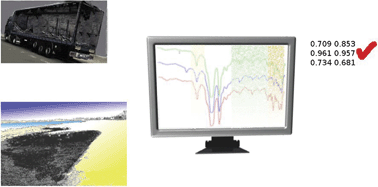Four comparison statistics (‘similarity indices’) for the identification of the source of a petroleum oil spill based on the ASTM standard test method D3414 were investigated. Namely, (1) first difference correlation coefficient squared and (2) correlation coefficient squared, (3) first difference Euclidean cosine squared and (4) Euclidean cosine squared. For numerical comparison, an FTIR spectrum is divided into three regions, described as: fingerprint (900–700 cm−1), generic (1350–900 cm−1) and supplementary (1770–1685 cm−1), which are the same as the three major regions recommended by the ASTM standard. For fresh oil samples, each similarity index was able to distinguish between replicate independent spectra of the same sample and between different samples. In general, the two first difference-based indices worked better than their parent indices. To provide samples to reveal relationships between weathered and fresh oils, a simple artificial weathering procedure was carried out. Euclidean cosine and correlation coefficients both worked well to maintain identification of a match in the fingerprint region and the two first difference indices were better in the generic region. Receiver operating characteristic curves (true positive rate versus false positive rate) for decisions on matching using the fingerprint region showed two samples could be matched when the difference in weathering time was up to 7 days. Beyond this time the true positive rate falls and samples cannot be reliably matched. However, artificial weathering of a fresh source sample can aid the matching of a weathered sample to its real source from a pool of very similar candidates.

You have access to this article
 Please wait while we load your content...
Something went wrong. Try again?
Please wait while we load your content...
Something went wrong. Try again?


 Please wait while we load your content...
Please wait while we load your content...